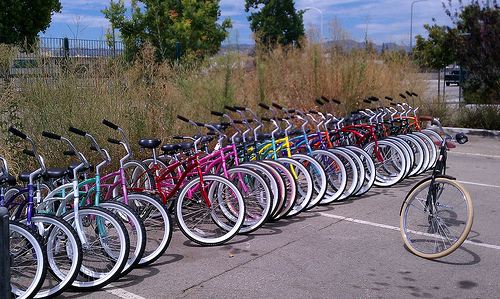AARP Hearing Center
Save Money With Public Bike Sharing Programs
By Jeff Yeager, September 3, 2013 04:35 PM

If you've traveled to many cities or college towns in the last couple of years, you've probably noticed fleets of nearly identical bicycles all parked together like a herd of dairy cows at feeding time.
Bike sharing programs have been commonplace in many other countries for a decade or even longer, and they're finally arriving here. More than 30 American cities and towns now have public bike sharing programs. New York City boasts the nation's largest program, with 6,000 bicycles available.
Worldwide, in just the last two years, the number of bicycles available through public bike sharing programs has more than doubled to an estimated 500,000 bikes. You can find a worldwide directory of bike sharing programs here.
So how does it work? Well, most every public bike sharing system is a little different. Most of them are operated either by the municipal government where they're based or by individual community groups or nonprofit organizations. The most common type of system involves inserting a credit card into a kiosk at a public bike station; a security deposit is placed on the card (refunded once you return the bike) as well the nominal cost to rent the bike based on how long you use it. Many programs also require you to purchase a membership or temporary access pass; those fees are typically modest as well.
Contest: Share your favorite one-tank road trip for a chance to win $100
Once your credit card has been processed, you are usually given an access code, which you then use to unlock the bike that you want to borrow from a bike rack at the station. The bikes tend to be pretty simple and heavy-duty but can be easily adjusted for a comfortable fit. Most systems are designed to encourage short usage of borrowed bikes - pedaling from point A to point B or running short errands, rather than keeping the bike for a whole day - so oftentimes the first half hour or so of the rental is free, with the hourly costs after that point gradually increasing the longer you keep it.
In nearly all programs you can drop off your bike at any station in the system, without any extra cost, so you don't have to return the bike to the station where you initially rented it. The minute you lock your bike into the stand at a station, the clock stops clicking and the security deposit is released from your credit card.
For many years, a favorite cheapskate travel trick of mine was to stop at a thrift store if I was going to be staying in a city or town for a few days and buy an inexpensive used bike for local commuting and sightseeing. Over the years it saved me a fortune in taxi fares, car rentals and public transportation, plus it provided some exercise and a chance to really see and experience the place I was visiting. And when I got ready to go home, I'd either donate the bike back to the thrift store where I bought it (resulting in a nice little tax deduction) or often give it to a kid who looked like he'd appreciate it.
Now with public bike sharing programs gearing up all around the country, I'll have another option for borrowing a temporary set of wheels and keeping down both my travel costs and my blood pressure at the same time.
Photo: Ubrayj02/flickr
Also of Interest
- Great ideas for great places: cycle tracks!
- Average 401(k) balances for 55-plus: $255,000
- Help AARP in the fight to end hunger
- Join AARP: Savings, resources and news for your well-being
See the AARP home page for deals, savings tips, trivia and more































































